Generative AI (GenAI) is transforming software development. Not only is the technology changing the way code can be written, but it’s also reshaping every stage of the development life cycle—from requirement gathering, system design, and solution development to user experience design, testing, and deployment. When rolled out at scale, GenAI will shift the quality, velocity, and economics of innovation, which may result in a strategic inflection point in the industry.
However, many software companies are finding it difficult to produce results from GenAI tools. They’re struggling to get their development teams to adopt them; and even if they use them, they haven’t figured out how to capitalize on the productivity gains. Several deeply entrenched factors—such as developers’ comfort with existing tools and inexperience with GenAI, the difficulties of managing organizational change, and structural impediments such as legacy code bases and the steep learning curve—prevent these firms from fully capitalizing on GenAI’s benefits.
In this article, we answer the tough questions about GenAI in software development. We show that companies have to go beyond merely deploying GenAI-based coding assistants and transform their organizations if they want to unlock the full value the new technology affords. Specifically, a software firm must create an effective learning journey, manage change carefully, alter its ways of working, and rethink the product development life cycle to optimize GenAI’s benefits. Our learnings stem from the software industry, but our experience shows that they apply to companies in any sector and in any function.
Detect the Barriers
GenAI is creating a lot of buzz, but its use isn’t as widespread as the hype would suggest. Three complications prevent companies from deploying it. (See Exhibit 1).
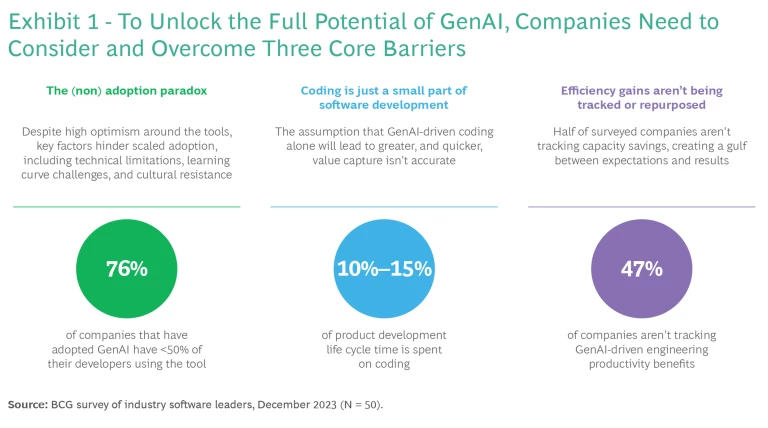
The (Non) Adoption Paradox
Despite the excitement, GenAI’s use in software development is still limited. Only 30% of software firms globally have deployed GenAI tools, according to surveys by Stack Overflow and Alteryx. BCG research further reveals that in roughly 75% of those early adopters, fewer than half of their developers have started using the tools. (See Exhibit 2.) At one software firm we worked with, fewer than 25% of developers were using the technology, although over 80% of them said they were optimistic about boosting productivity with GenAI. This isn’t an isolated example; our research shows that the gap between intentions and adoption is pervasive.
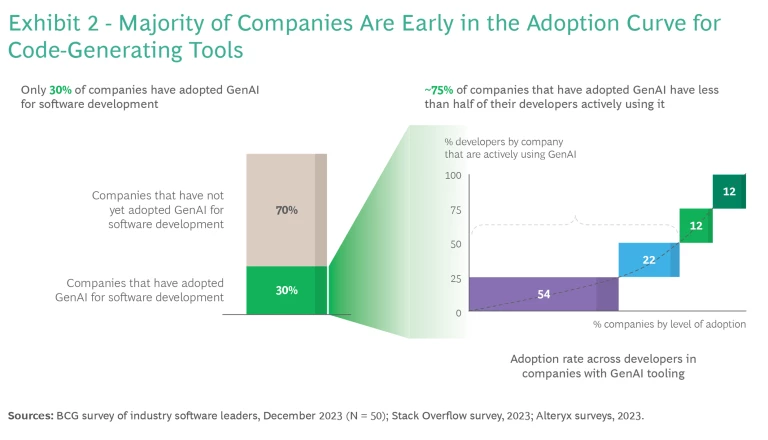
Several factors, we find, are combining to prevent GenAI’s adoption.
Context. Not all software development teams reap the same productivity gains from using GenAI: some generate more value, others much less. Benefits depend on:
- Codebase Maturity. GenAI tools work well at present for writing new code, helping to develop new features and products and generating code for freshly conceptualized components. Their usefulness is more limited when they work with mature codebases. Lacking contextual understanding, GenAI still struggles with internal libraries and application programming interfaces, complex debugging, and refactoring. In one of the pilots we conducted, even using the tool’s ability to be tuned on a full codebase didn’t completely address these challenges—although there are bound to be improvements over time.
- Use Case. GenAI tools can handle routine coding tasks such as creating boilerplate code and designing standard web applications and interfaces. However, at present, they can’t cope with scenarios that involve high algorithmic complexity, managing technical debt, and refactoring complex code, where comprehending legacy codebase is crucial. However, as large language models’ capabilities improve, GenAI tools will become more effective at executing a wider variety of software-related tasks.
- Developer Experience. Our pilot programs showed that while all developers see productivity gains, the extent varies subtly according to level of experience and tenure. Midlevel developers reaped the greatest benefits from GenAI tools because they possessed enough experience to effectively utilize and refine AI-generated code. Junior developers also benefited, but less so because of their relative lack of experience in assessing code quality. Senior developers, proficient in specific frameworks and languages, experienced the smallest incremental gains. (See Exhibit 3.) A developer’s familiarity with a language or framework also played a role. For instance, one senior developer, who didn’t integrate GenAI into the routine for languages he knew, found it useful when working with unfamiliar coding languages.
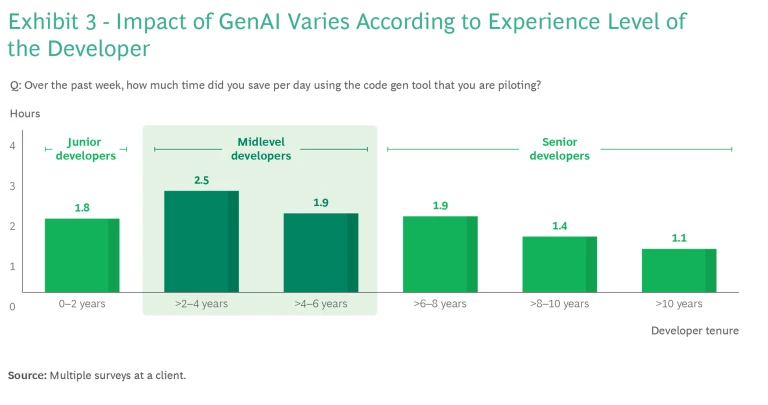
- Technology Stack. GenAI products work well with popular technology stacks leveraging languages such as JavaScript, C++, Java, and Python as well as standard frameworks such as Spring and React. That’s because the open-source repositories and other data sets used to train these models have a greater volume of code in more popular languages and well-established frameworks. The tools are generally less effective with emergent frameworks; outdated languages like Fortran and COBOL (unless these models have been custom built or tuned on specialized languages; e.g., IBM WatsonX for Z to modernize COBOL applications); and niche languages such as Erlang and Rust. These less popular resources often produce suboptimal suggestions and hallucinations.
Technical Limitations. GenAI’s capabilities may be advancing rapidly, but they’re hampered by several issues. At the C-level, concerns about security vulnerabilities and intellectual property issues related to generated code persist, making firms cautious about using the technology. Developers face their own challenges. For one thing, there’s inconsistent support from integrated development environments for GenAI tools. For another, the risks of suboptimal outputs and hallucinations mentioned above also hinder adoption.
A lot of these limitations will be overcome in the future. Static code analysis and software composition analysis tools will address cybersecurity and IP usage concerns. Licensing arrangements are bound to change too; a few GenAI vendors already offer some kind of indemnification to mitigate legal concerns. And over time, the models underpinning GenAI will become capable of generating higher-quality code. But there’s a long way to go.
Learning Curve. Climbing the GenAI learning curve takes time. Adoption is slower than expected in most software organizations, we find. Developers have to adapt to new tools, learn effective prompt engineering, and change workflows by, say, using chat for code review, refactoring, code discovery, and debugging. Facing deadline pressures, most developers revert to the methods they already know, which hinders implementation of GenAI at scale.
The Human Factor. People and biases also generate resistance to deployment. Senior developers, perceived by peers to be role models, can sometimes dismiss the tools’ capabilities, swaying their teams’ sentiments against GenAI. When we interviewed software engineering executives, some also expressed concern over junior engineers’ potential overreliance on generated code, which can lead to poor output and future maintainability issues. Our experience also suggests that there is an underlying sense of unease among some developers, who worry that GenAI tools could replace them and so push back against adoption.
Coding Is Just a Small Part of Software Development
The assumption that GenAI-based coding will lead to greater, and quicker, value capture isn’t accurate. Sure, using GenAI assistants reduces the time required for coding, but in our experience, coding accounts for only 10% to 15% of the time from when an idea joins the queue to when the product gets into customers’ hands. (See Exhibit 4.) In contrast, strategy, planning, and conceptualization account for a lot of the lead time. And at the other end of the process, release times—which include product introduction and launch as well as implementing pricing changes, tech support, and sales enablement—account for 30% to 40% of the development life cycle. That’s why GenAI’s impact on the product development process is limited in many early pilots. In all our pilots, while developers reported saving time and generating code faster by using GenAI, the velocity of innovation or time to market didn’t change much over a three-month period.
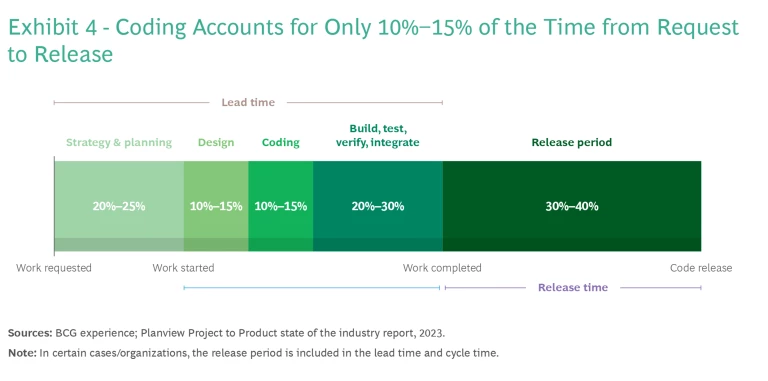
Thus, if it takes a long time to deliver a product to customers after its development, the time to market will be a handicap even if GenAI did speed up the coding. Companies that want to use the technology to produce business results must therefore look beyond using GenAI for just coding and deploy it across the entire product development and delivery life cycle.
Efficiency Gains Aren’t Being Tracked or Repurposed
Our research shows that about 50% of the software companies leveraging GenAI are not really capturing much benefit from these new tools. Specifically, 15% of these companies report a lack of visibility into the benefits they yield. Furthermore, 32% have no plan for reallocating the efficiency gains realized by their software engineers. This suggests that many organizations are not fully capturing the potential ROI that GenAI tools can offer, as they have yet to repurpose the freed-up developer resources effectively. (See Exhibit 5.)
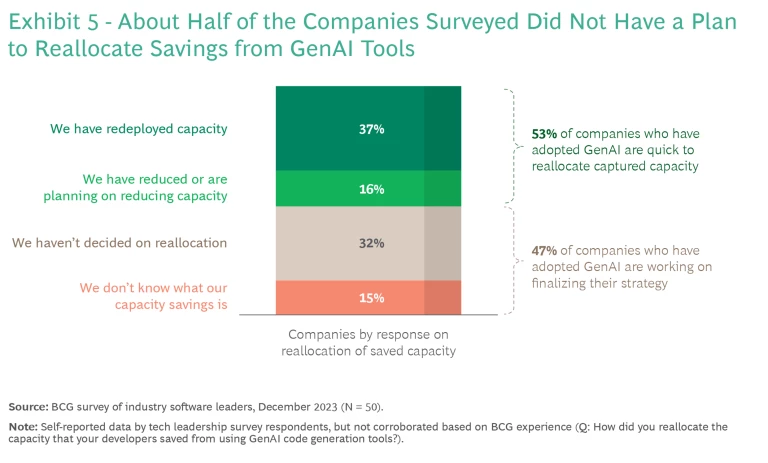
While over half of the surveyed firms claim to harness GenAI’s benefits, closer scrutiny reveals that these are generally anticipated reallocations or intentions rather than actual cost reductions. In reality, many of the projected advantages of GenAI remain unrealized, leading to a significant gap between expected outcomes and actual results.
Overcome the Challenges
To take full advantage of GenAI, software companies must treat its introduction as just one piece of an organizational transformation. According to our research, most companies trying to generate value from their investments in the technology have found it difficult to change developers’ work habits. Seventy-five percent of our respondents reported that the biggest challenge in adopting GenAI tools was the “inertia in changing ways of working”—not technical issues.
Against that background, software companies can take several steps to encourage GenAI’s adoption at three stages.
Lay the Foundations
Choose and sequence use cases. Since GenAI’s impact depends heavily on context, as we pointed out earlier, pick the right use cases when starting out and prioritize their sequence carefully. GenAI will be more valuable in developing new code in a widely used programming language, for instance, than trying to refactor legacy codebases or writing functionality in niche programming languages. Encouraging developers to use GenAI to do the former will result in quick and early wins.
Just as important, picking the right use cases will prevent developers from hitting stumbling blocks that make them question GenAI’s value and discard it before the effort get off the ground. At one client, we doubled adoption rates from roughly 25% to 50% by guiding developers to use GenAI for new code development, as opposed to using it for bug fixing in their existing codebase.
Measure and manage. Companies can’t manage what they don’t measure, so develop a 360-degree approach to track GenAI’s impact. Starting with the basic metrics—such as adoption rates, usage data, acceptance rates, code produced, and time saved—is logical.
Adoption metrics, such as the number of daily active users and the number of lines of code generated and accepted, are necessary, but not sufficient. To understand the technology’s impact, software firms must assess engineering and process metrics such as cycle times and code quality as well as operational metrics such as deployment frequency and mean time to repair. The right metrics will differ for each organization and even for each team, depending on the software type; the deployment model; and the work—for example, feature development or technical debt remediation—that the team is doing.
Finally, companies must also measure developers’ satisfaction with GenAI. More than just driving executive-level visibility, employee experience metrics will be instrumental in understanding adoption and the returns from the technology. They will help pinpoint where to pivot and reallocate resources. In our pilots, setting up a 360-degree measurement framework that included biweekly pulse checks was instrumental in keeping organizations agile, understanding where adoption was happening (and where it wasn’t), and driving managerial interventions.
Manage the Change
Keep the developer at the center of transformation. In our pilots, software developers’ insufficient ability and motivation was a real barrier to adoption. To overcome this, companies must kick off a developer-centered transformation and invest heavily in change management. Three actions will help tackle organizational inertia head-on:
- Set up a central team, or a center of excellence. This function will plan, sequence, and implement GenAI pilots across the organization. It is most effective when led by a developer or a senior leader of the product/engineering team who understands the company’s code base and technology choices; has a view of all its use cases; holds peers’ respect; and is comfortable championing the technology. At one client, when the development organization’s leaders, engineering leads, and chief product officer all leaned into the pilot, their advocacy immediately led to higher engagement. It also resulted in a better understanding of the context in which GenAI worked better, which helped the company’s leaders pick new use cases more effectively.
- Create demand for GenAI from developers. Start the transformation with use cases that resonate with engineers. For instance, emphasizing new skill development and affording the time to develop newer features and value-added tasks, such as designing next-gen architectures, will generate more interest in adoption. Leaders can demonstrate that, by reducing developers’ burden of routine tasks, more time can go toward higher-value—and likely more interesting and motivating—work. Unfortunately, the initial conversation is often only about productivity, which ignites fears and doesn’t inspire developers.
- Help employees elevate their purpose and capability with GenAI. A critical barrier to applying GenAI in software development (or for other purposes) arises when a task that GenAI is able to perform challenges human employees’ capabilities. Many developers feel that their key capability is coding and question the quality of GenAI-created code. Leaders can catalyze adoption by developers only if they connect the dots about how the organization’s purpose and ways of working will be elevated by GenAI’s use.
Focus on intentional learning. As noted above, implementing GenAI in software development comes with a steep learning curve. Two out of three software firms that have adopted GenAI admit that lack of training is a problem. And at least 50% indicate that the lack of sufficient time for learning is an adoption barrier. In addition to new skills, such as prompt engineering, and augmented skills, such as code reviewing and cybersecurity, working with GenAI demands a different work rhythm, sometimes on vastly different tool sets.
Many developers are reluctant to adopt GenAI tools because of the switching costs. For instance, one developer we interviewed used Vim for all his editing and was reluctant to switch to Visual Studio because of the learning costs. Several developers expressed concerns about workloads, indicating that the initial productivity decrease associated with adapting to new workflows makes it challenging to switch to GenAI tools. To address this issue, organizations must incorporate three factors into their learning approach:
- Create a multipronged learning journey. For software developers, learning won’t take place only during formal sessions or vendor-driven programs. An effective learning journey will consist of a mix of both including a kickoff event that addresses the purpose and strategy for GenAI in the context of a team’s work as well as the technology; a series of vendor-driven asynchronous training sessions; informal learning forums such as office hours and town halls; and individual experimentation time. We found that informal peer-to-peer sessions, where developers shared experiences and best practices, received the most positive feedback. In fact, developers who had been invited forwarded invitations for peer sessions to others, who joined them. One developer told us that he joined focus groups that were meant to share feedback on the tools simply to learn how other developers used the tools.
- Each developer’s learning should be customized by role, tenure, coding activity, and application because how a developer uses GenAI tools as well as their effectiveness vary according to these factors. Developers found training more applicable when it was relevant to their workflows. Such a segmented learning approach avoids the risk of overpromising the technology’s benefits to developer cohorts that see limited value from it such as a senior developer fixing inline bugs in a codebase. While junior developers will need training in core programming frameworks and architecture patterns to effectively use GenAI, senior developers will have to reimagine their roles and model GenAI’s use for juniors.
- Companies must create and protect learning capacity to drive faster adoption. When developers were under tight deadline pressure, they were less likely to invest the time to learn GenAI. In the pilot where we identified this challenge, we used learning sprints—a targeted period of between one week and two weeks—to give software developers the time to learn without having to manage their regular workloads. In practice, this meant reducing the number of priorities for a single sprint by at least 50% or doubling the sprint timelines to accommodate the productivity dip. Doing so alleviated the pressure on the developers, who became more adept in the use of the GenAI tools in that time.
Reimagine the Future
Rethink talent and structure. Most companies are just beginning to consider GenAI’s likely impact on their talent strategies. Our research found that across roles, up to 70% of existing skills in organizations will be augmented or disrupted by GenAI. For example, the pilots we conducted underscored the fact that software developers will require new skills such as prompt engineering to generate code, the ability to review AI-generated code for quality and security, and an understanding of the legal and ethical implications of using such code.
As GenAI is increasingly integrated into the software development process, how the product development organization spends its time will change. Developers will spend less time on iterative coding and more on designing, problem solving, and building new features. Product managers will spend less effort on crafting product requirement documents and develop the ability to rapidly create prototypes themselves. Exercising business judgment and other leadership skills will become increasingly important as managers determine how to integrate GenAI tools while addressing issues such as bias against the technology and compliance with regulations.
In the short run, software firms can focus on developing the needed skills in their existing workforces. Roles will evolve in ways that drive better outcomes. Product managers, for instance, may expand their remit to focus on design and prototyping as well as engage closely with cross-functional teams. Developers may become more customer-centric, taking on challenges such as mitigating technical debt and boosting system scalability earlier and more effectively.
At the organization level, the transition will require rethinking the intake funnel for junior developers as well as determining how GenAI will affect optimal team sizes and tenure mixes. Our pilots lead us to believe that all aspects of an enterprise software firm’s human resources strategy—from organization structure to hiring and onboarding developers, from development focused on cybersecurity to new role definitions and responsibilities—will be impacted.
Be relentlessly value focused. The aim of integrating GenAI in software development extends beyond usage; it’s about realizing tangible business benefits—accelerating innovation, speeding up market delivery, enhancing customer satisfaction, and improving financial performance. Many companies investing in GenAI for software development today aren’t clear about their business goals, and aren’t adequately preparing to realize the technology’s benefits, which are often hidden and not yet impacting the ultimate goal of faster product delivery.
We see three strategies to resolve these problems. First, when searching for value, broaden the aperture for GenAI use beyond coding, formulating a strategy that spans the entire software development spectrum—product management; design; development; quality assurance; security, and operations; and even level 3 support. In our experience, there is potential for organizations to save 10% to 20% of R&D time—half of which will come from coding. (See Exhibit 6.) It is also important to anticipate and proactively invest in automation improvements in security (e.g., static code analysis), and testing automation to account for accelerated software development velocity.
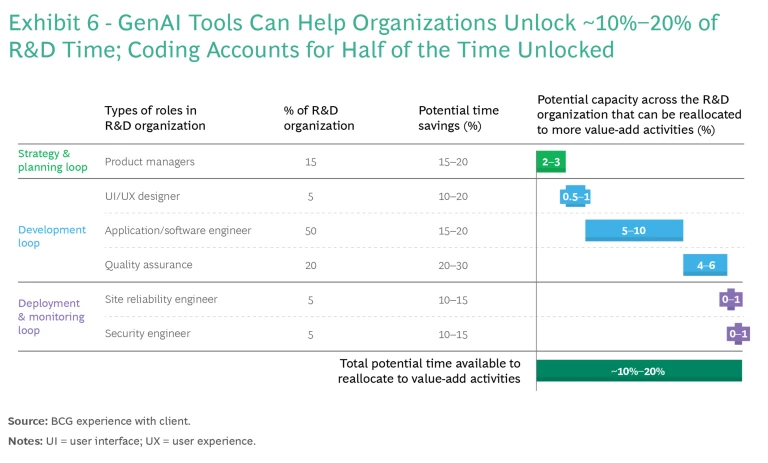
Second, reinvent workflows. Software development accounts for only a fraction of the product development life cycle, as we pointed out earlier. Companies must revamp their pre-development processes—such as planning and prioritization—as well as post-development processes—new product introduction, sales and partner enablement, and product marketing—that act as choke points.
Finally, it is essential for companies to capture the benefits they realize. Time savings and faster software development are the immediate advantages, so organizations must be intentional in leveraging those efficiencies for greater value by adapting their resource allocation, hiring plans, and roadmaps.
GenAI is likely to bring about disruptive changes in software development, so it’s imperative that companies start on the journey today. As the technology matures, organizations that engage with it right away will be able to learn, adapt, and innovate sooner, turning potential disruptions into business opportunities. Those that delay risk falling behind because the impact gap between traditional methods and GenAI will only widen over time. Realizing GenAI’s potential calls for an openness to changing not just the tools that software developers use, but also their ways of working, organization structures, and mindsets.
As we step forward, the real work begins in driving adoption and reshaping the future of software development.
Acknowledgments
The authors would like to thank Amit Kumar, Clark O’Neil, Renee Laverdiere, Derek Kennedy, Sesh Iyer, Allison Bailey, Pedro Couto, Tim Lattimer, Purva Chopra, and Ian Macdonald for their contributions to this article.













